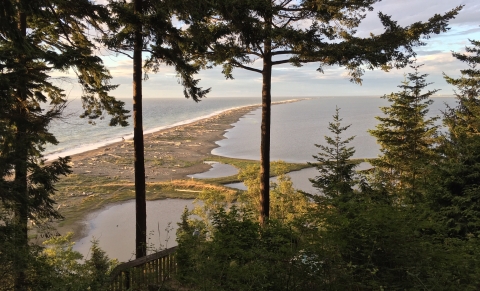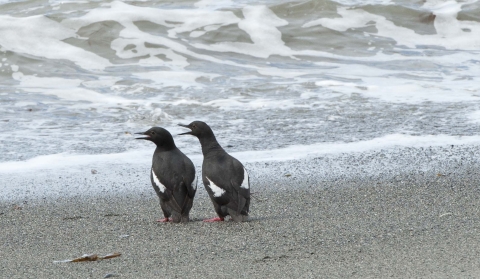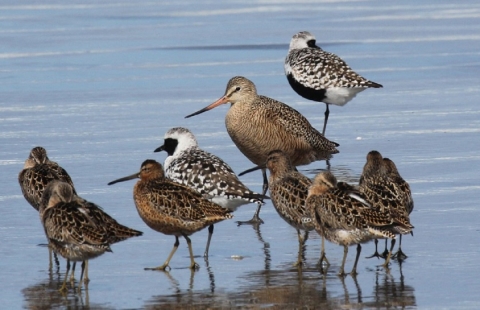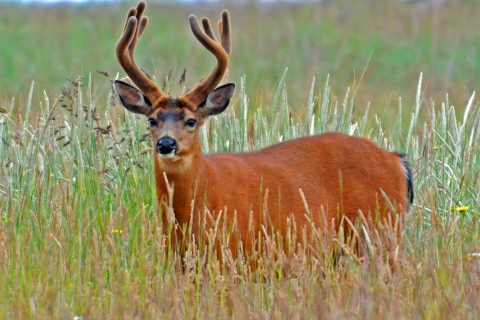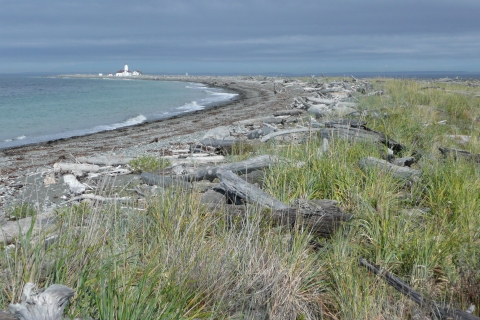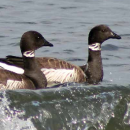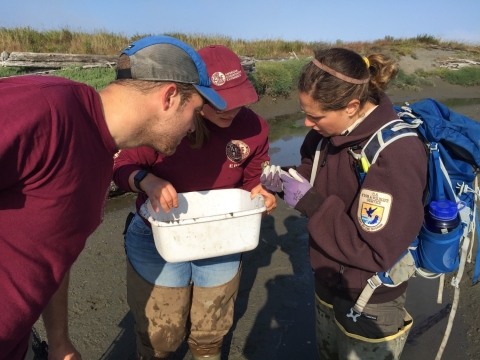Recognizing the importance of the fertile habitats, President Woodrow Wilson established the Dungeness National Wildlife Refuge on January 20, 1915 as a refuge, preserve, and breeding ground for native birds. Today the graceful arc of Dungeness Spit continues to protect nutrient-rich tideflats for migrating shorebirds in spring and fall; a quiet bay with calm waters for wintering waterfowl; an isolated beach for harbor seals and their pups; and abundant eelgrass beds for young salmon and steelhead nurseries.
In every outthrust headland, in every curving beach, in every grain of sand there is the story of earth.
- Rachel Carson
Visit Us
Plan before you go! Thousands of visitors appreciate the natural beauty of Dungeness National Wildlife Refuge each year. Take a few minutes to review hours, fees, and regulations before you head out on your adventure.
Location and Contact Information
About Us
Dungeness National Wildlife Refuge is open to the public year-round. Hiking, wildlife viewing, and photography are popular activities on the Refuge. Some portions are closed seasonally or permanently to protect sensitive species. To ensure that wildlife continue to have a peaceful place to rest and feed, certain recreational activities such as swimming, jogging, and other beach activities are allowed only in selected areas during certain times of the year. Pets, bicycles, kite flying, frisbees, flying machines, ball-playing, camping, and fires are not permitted in the Refuge as they are a disturbance for the many migrating birds and other wildlife taking solitude on the Refuge.
What We Do
Resource Management
Dungeness National Wildlife Refuge protects critical habitat for wildlife and provides viewing opportunities for people. To ensure that wildlife continue to have a place to rest and feed, some recreational activities are allowed only in selected areas during certain times of the year and some portions of the Refuge are entirely closed to the public. The Refuge has an active program of volunteers helping with public information, education, maintenance, and wildlife protection. Other Refuge management activities include wildlife surveys, invasive species invasive species
An invasive species is any plant or animal that has spread or been introduced into a new area where they are, or could, cause harm to the environment, economy, or human, animal, or plant health. Their unwelcome presence can destroy ecosystems and cost millions of dollars.
Learn more about invasive species mitigation, public education, and marine debris clean-up.
In 1990, Graveyard Spit was designated as a Research Natural Area (RNA) due to its unique vegetation. In RNAs, natural processes are allowed to predominate without human intervention. Activities on RNAs are limited to research, study, observation, monitoring, and educational activities that are non-destructive, non-manipulative, and maintain unmodified conditions.
Our Organization
Washington Maritime National Wildlife Refuge Complex
Dungeness National Wildlife Refuge is managed as one of six refuges in the Washington Maritime National Wildlife Refuge Complex. A Refuge Complex is an administrative grouping of two or more refuges, wildlife management areas or other conservation areas that are primarily managed from a central location. Refuges are grouped into a complex structure because they occur in a similar ecological region, such as a watershed or specific habitat type, and have a related purpose and management needs.
Typically, a project leader or complex manager oversees the general management of all refuges within the complex while refuge managers may be responsible for operations at specific refuges. Staff are generally, but not always, centrally located and support all refuges within the complex.
The Washington Maritime Complex is headquartered at the Dungeness National Wildlife Refuge near Sequim, WA.
Our Species
With diverse habitats from vernal ponds to a saltwater bay, Dungeness supports hundreds of animal and plant species.
Birds
Originally set aside as a refuge for migratory birds, Dungeness provides safe harbor for a variety of sea birds, shore birds, and many others.
Mammals
From the Douglas' squirrels chattering in the tree branches to harbor seals resting on shore, mammals abound throughout Refuge habitats.
Habitats
Dungeness protects a rich fusion of habitats for wildlife. Where land and sea meet, many species thrive.
Species Directory
Our Library
Brochures, Maps, and Publications
View our galleries for wildlife found at Dungeness National Wildlife Refuge.
Projects and Research
- Dawley Estate Shoreline Restoration
- European Green Crab Mitigation
- Invasive Plants Mitigation
- Wildlife Surveys
- Parking Lot and Public Restrooms Renovation




